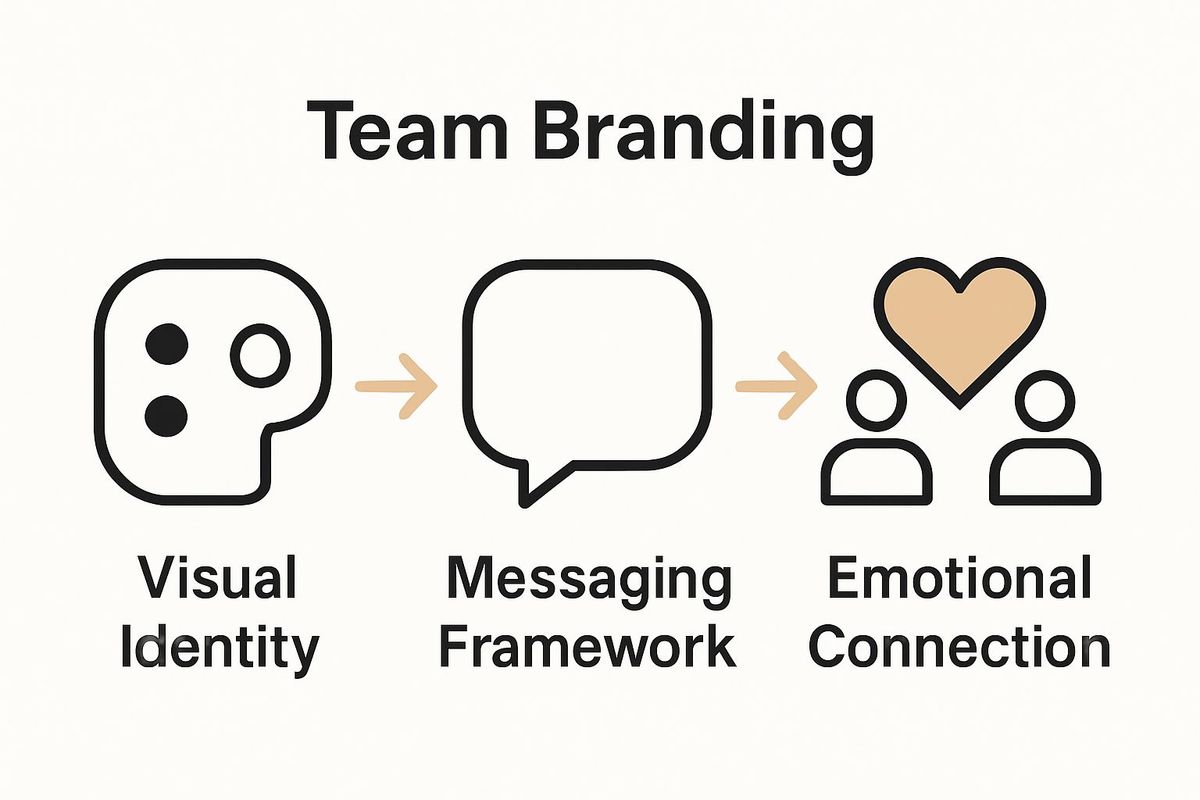Understanding the Role of Branding in Team Building
October 8, 2025

Building a team is about more than just putting people together in the same room. Most people think that branding is all about flashy logos and catchy slogans, but the real magic happens behind the scenes. When branding is done right, it can actually boost team cohesion by as much as 25 percent according to research from the National Center for Biotechnology Information. That means a brand is not just your company’s face, it shapes the heart and drive of your team from the inside out.
Table of Contents
- Defining Branding And Its Core Elements
- The Importance Of Branding In Team Dynamics
- How Branding Shapes Team Identity And Culture
- Real-World Examples Of Branding In Team Building
- Strategies For Implementing Branding In Teams
Quick Summary
| Takeaway | Explanation |
|---|---|
| Branding creates organizational identity. | A strong brand helps establish a unique identity and differentiates an organization in the marketplace. |
| Effective branding enhances team cohesion. | Aligning individual and collective goals strengthens team dynamics and fosters collaboration among members. |
| Emotional connections drive motivation. | Team members who identify with a strong brand feel a deeper commitment to shared objectives and values. |
| Clear narratives enhance culture. | Compelling stories transform organizational missions into meaningful individual experiences, fostering a sense of belonging. |
| Implementing branding requires a strategic approach. | A deliberate strategy integrating vision, values, and consistent narrative helps solidify team identity and engagement. |
Defining Branding and Its Core Elements
Branding represents a strategic process of creating a distinctive and memorable identity for an organization, team, or product. American Marketing Association defines branding as the complex method of developing a unique name and image that establishes a significant and differentiated presence in the marketplace.
The Fundamental Components of Branding
Branding encompasses several critical elements that work together to create a comprehensive organizational identity. At its core, branding involves visual, emotional, and strategic dimensions that communicate an organization's values, personality, and unique proposition.
Below is a table summarizing the fundamental components of branding discussed in this section to provide a clear overview of each element and its purpose.
| Component | Description |
|---|---|
| Visual Identity | Logos, color schemes, typography, and design elements for instant recognition |
| Messaging Framework | Consistent communication style, tone, and narrative reflecting organizational values |
| Emotional Connection | Psychological and emotional relationship between the organization and stakeholders |
| Value Proposition | Unique set of benefits and distinguishing factors presented to the target audience |
| Cultural Alignment | Integration of brand identity with the organization’s shared beliefs and practices |

- Visual Identity: Logos, color schemes, typography, and design elements that create immediate visual recognition
- Messaging Framework: Consistent communication style, tone, and narrative that reflects organizational values
- Emotional Connection: The psychological and emotional relationship established between the organization and its stakeholders
Strategic Purpose of Branding
Effective branding goes beyond mere aesthetic design. It serves as a powerful communication tool that helps teams and organizations articulate their unique value proposition. By developing a clear and consistent brand strategy, teams can create a sense of unity, shared purpose, and collective identity. Read more about customizable branding strategies to enhance your team's collaborative potential.
The strategic purpose of branding in team building involves creating a cohesive narrative that aligns individual team members with broader organizational goals. This alignment helps transform a group of individuals into a unified, motivated collective that understands and embodies shared values and objectives.
Ultimately, branding acts as a fundamental mechanism for building trust, establishing credibility, and fostering a strong sense of belonging within teams and organizations.
The Importance of Branding in Team Dynamics
Team branding transforms how individuals perceive and interact within organizational environments. Research from the National Center for Biotechnology Information reveals that effective branding enhances team cohesion by aligning individual values with collective goals, creating a powerful psychological framework for collaboration.
Psychological Impact of Team Branding
Team branding operates at a deeper psychological level, influencing individual and collective motivation. When team members identify with a strong, consistent brand, they experience a sense of belonging that transcends individual roles. This psychological connection generates several critical outcomes:
- Identity Alignment: Helps team members understand their role within the larger organizational context
- Emotional Investment: Creates a deeper commitment to team objectives and shared mission
- Intrinsic Motivation: Stimulates personal engagement beyond traditional performance metrics
Building Collective Identity Through Branding
Successful team branding requires more than superficial visual elements. It demands a comprehensive approach that integrates shared values, communication strategies, and collaborative practices. Explore our guide on custom branding techniques to understand how strategic branding can transform team dynamics.
The process involves creating a narrative that resonates with team members, making them feel integral to the organization's broader mission. By developing a distinctive team identity, organizations can cultivate a sense of pride, mutual respect, and collective purpose that drives performance and innovation.
Ultimately, team branding serves as a powerful mechanism for uniting diverse talents, perspectives, and skills into a cohesive, high-performing unit that can adapt and excel in complex professional environments.
How Branding Shapes Team Identity and Culture
Team branding serves as a powerful mechanism for constructing and reinforcing organizational culture, transforming abstract concepts into tangible experiences. According to research from the National Institutes of Health, a robust internal brand identity significantly contributes to positive team dynamics by clarifying behavioral expectations and enhancing organizational commitment.
Cultural Architecture Through Branding
Branding functions as an intricate cultural architecture that goes beyond visual representation. It creates a comprehensive framework that defines how team members perceive themselves, interact with each other, and understand their collective purpose. This cultural blueprint encompasses several critical dimensions:
- Shared Value System: Establishes common principles that guide team behavior
- Communication Protocol: Defines acceptable communication styles and interaction norms
- Performance Expectations: Sets implicit and explicit standards for professional conduct
Narrative and Symbolic Representation
Effective team branding transforms organizational goals into compelling narratives that resonate with individual team members. Learn more about event branding strategies to understand how storytelling can enhance team connectivity. The narrative aspect of branding helps translate abstract organizational mission into meaningful personal experiences, allowing team members to see themselves as integral parts of a larger, purposeful ecosystem.
By creating a strong, consistent brand identity, organizations can cultivate a sense of belonging that transcends traditional hierarchical structures.
 This approach enables teams to develop a unique cultural DNA that distinguishes them, promotes innovation, and creates a supportive environment where individuals feel valued and understood.
This approach enables teams to develop a unique cultural DNA that distinguishes them, promotes innovation, and creates a supportive environment where individuals feel valued and understood.
Ultimately, team branding is not merely about external perception but about creating an internal ecosystem that nurtures collaboration, mutual respect, and collective achievement.
Real-World Examples of Branding in Team Building
Practical applications of team branding demonstrate how strategic identity development can transform organizational performance and team dynamics. According to organizational psychology research from Stanford University, successful team branding goes beyond aesthetic design to create meaningful psychological connections.
Corporate Culture Transformation
Leading organizations have implemented innovative branding strategies that fundamentally reshape team interactions and performance. These real-world examples illustrate the profound impact of deliberate branding approaches:
This table compares real-world corporate team branding examples and highlights their focus and impact, helping readers understand different approaches to implementing branding in team building.
| Organization | Branding Focus | Impact on Team Dynamics |
|---|---|---|
| Collaborative culture, open communication | Fosters creativity, innovation, and team collaboration | |
| Zappos | Employee happiness, customer service | Builds a strong internal brand and team commitment |
| Spotify | Agile team identities, experimentation | Encourages learning, adaptation, and cross-team synergy |
- Google's Collaborative Culture: Emphasizes open communication, creativity, and shared innovation through consistent visual and narrative branding
- Zappos' Unique Identity: Develops a strong internal brand focused on employee happiness and customer service excellence
- Spotify's Agile Branding: Creates cross-functional team identities that encourage experimentation and continuous learning
Technology and Startup Ecosystem Approaches
Technology companies have been particularly adept at using branding as a team-building mechanism. Explore our insights on custom branding techniques to understand how innovative organizations develop distinctive team identities. Startups often use branding to create a sense of mission, attract talent, and differentiate themselves in competitive markets.
These organizations recognize that effective team branding is not about creating superficial marketing materials, but about developing a comprehensive ecosystem that aligns individual aspirations with collective goals. By crafting compelling narratives, visual identities, and shared values, they transform traditional workplace dynamics into collaborative, purpose-driven environments.
Ultimately, these examples demonstrate that successful team branding requires a holistic approach that integrates visual design, communication strategies, and deeply held organizational values.
Strategies for Implementing Branding in Teams
Successful team branding requires a deliberate and strategic approach that integrates organizational goals with individual team member experiences. Research from Harvard Business Review emphasizes the importance of creating a comprehensive framework that resonates with team members at multiple levels.
Foundational Branding Development
Implementing effective team branding begins with establishing a robust foundation that captures the essence of the organization's identity. This process involves developing critical elements that form the core of team branding strategy:
- Vision Articulation: Clearly define and communicate the team's overarching purpose and long-term objectives
- Value Alignment: Ensure that brand elements reflect the authentic core values of the organization
- Consistent Narrative: Create a compelling story that connects individual roles to broader organizational goals
Practical Implementation Techniques
Transforming branding concepts into tangible team experiences requires strategic and intentional approaches. Discover advanced branding implementation methods to enhance your team's collaborative potential. Organizations can leverage various techniques to embed branding into team culture, including:
- Interactive workshops that explore team identity
- Regular communication reinforcing shared values
- Recognition programs that celebrate brand-aligned behaviors
Successful branding implementation goes beyond surface-level design. It demands a holistic approach that integrates visual elements, communication strategies, and meaningful engagement mechanisms. Teams must view branding as a dynamic, evolving process that continuously adapts to changing organizational needs and individual team member perspectives.
Ultimately, effective team branding transforms from a top-down directive to a collaborative journey of collective identity creation, where every team member becomes an active participant in shaping and representing the organization's unique cultural narrative.
Transform Your Team Identity with Customizable Game Experiences
Building a strong brand within your team is not just about words or logos. As discussed in the article, genuine team branding goes deeper — it shapes culture, promotes unity, and ignites motivation. Yet even with a compelling message, many organizations struggle to bring their brand to life in a way that boosts collaboration and engagement. If you want to inspire real belonging and turn shared values into shared success, your team needs interactive ways to embody that identity every day.

Ready to see immediate impact? With Quizado's customizable quiz platform, you can create unforgettable team-building experiences that reflect your unique brand. Personalize your games with your own logos and messaging, reinforce your mission through engaging challenges, and watch as team spirit comes alive during every session. Take advantage of this opportunity to embed your brand into lasting team culture. Start now at Quizado’s main site and discover how easy it is to turn branding concepts into everyday team wins.
Frequently Asked Questions
What is the importance of branding in team dynamics?
Effective branding enhances team cohesion by aligning individual values with collective goals, fostering collaboration, and building a sense of belonging among team members.
How can team branding impact motivation within an organization?
Team branding creates emotional connections among members, leading to greater identity alignment, emotional investment, and intrinsic motivation towards shared objectives.
What are the core elements involved in team branding?
The core elements of team branding include visual identity (logos, color schemes), messaging framework (communication style), and emotional connections that reflect organizational values.
How can organizations implement effective branding strategies for teams?
Organizations can implement effective branding strategies by articulating a clear vision, aligning values with brand elements, and creating consistent narratives that engage team members in their roles within the organization.



